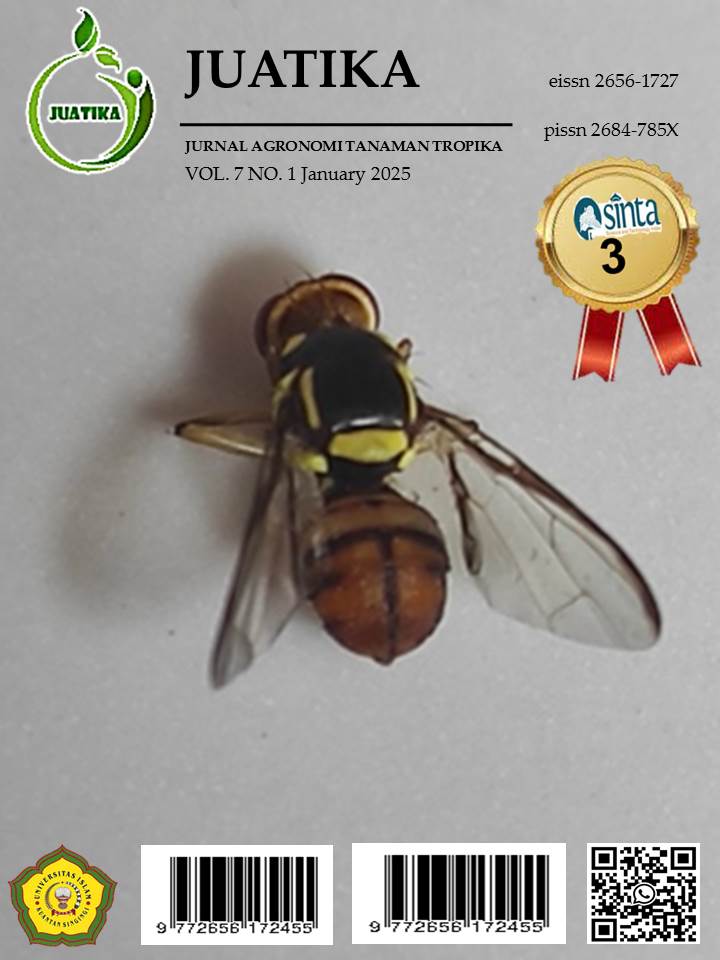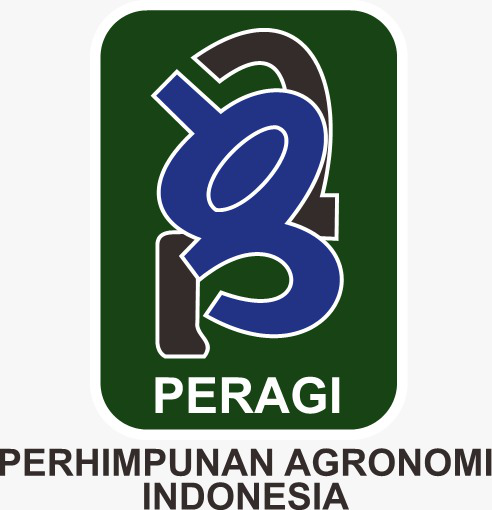Potential Antioxidant Content of Three Types of Mimosa Weed from Various Plant Parts using The DDPH (2,2-diphenyl-1-picrylhydrazyl) Method
Abstract
Antioxidants are essential for neutralizing free radical and their presence in plants like mimosa weeds could be beneficial for various applications, include medical uses and agricultural development. This research focus on the potential antioxidant content of mimosa weed species (Mimosa pudica L., Mimosa invisa L., Mimosa pigra L.) from various plant parts (roots, stems, leaves and seed) using the DPPH method (2,2-diphenyl-1-picrylhydrazyl). This study aims to understand the interaction between different types of mimosa weeds and various plant parts in relation to antioxidant activity levels, as well as phytochemical content across the three types of Mimosa sp. using the DPPH method and determine the best-performing weed and plant parts based on the smallest IC50 value and highest phytochemical content. This research was conducted in Padang City. Sample drying and extraction were carried out at the Plant Physiology Laboratory, Faculty of Agriculture, Andalas University, and phytochemical tests were performed at Vahana Scientific Laboratory Padang. The research took place from February to May 2024. The design used was a factorial Completely Randomize Design (CRD). The first factor is the treatment of Mimosa sp. weed species, namely: Mimosa pudica L., Mimosa invisa L. and Mimosa pigra L. The second factor was the treatment of different parts of the Mimosa sp. Namely: root, stem, leaf and seed. From these two factors, 12 treatment combinations were obtained, each repeated three times, resulting in a total of 36 experimental units. The research data were analyzed statistically with the F test at the 5% level and if F count > F table at 5%, then it continued with Duncan’s New Multiple Range Test (DNMRT) at the 5% level. The results showed that there was an interaction between mimosa weed species and plant parts in terms of antioxidant activity, as indicated by the IC50 values. The strongest antioxidant was found in the leaves of Mimosa pigra L., with an antioxidant value of 41.89 mg/L.
Downloads
References
Agustina, S., Ruslan, & Wiraningtyas. (2016). Skrining fitokimia tanaman obat di Kabupaten Bima. Journal of Applied Chemistry, 14(1), 71–76.
Azmi, L., Singh, M. K., & Akhtar, A. K. (2011). Pharmacological and biological overview on Mimosa pudica L. International Journal of Pharmacy & Life Sciences, 2(11), 1226–1234.
Dalimartha, S. (2008). Resep tumbuhan obat untuk asam urat. Jakarta: Penebar Swadaya.
Departemen Kesehatan RI. (1979). Farmakope Indonesia (Edisi III). Jakarta: Departemen Kesehatan RI.
Febrianti, Y., Krisnawati, Y., & Riastuti, R. D. (2022). Pengetahuan masyarakat terhadap pemanfaatan bambu sebagai tumbuhan obat. Bioedusains: Jurnal Pendidikan Biologi dan Sains, 5(1), 221–234.
Hidayati, J. R., Ridlo, A., & Pramesti, R. (2017). Aktivitas antioksidan ekstrak rumput laut Padina sp. dari perairan Bandengan Jepara dengan metode transfer elektron. Buletin Oseanografi Marina, 6(1), 46–52. https://doi.org/10.14710/BULOMA.V6I1.15742
Jannah, N. T., Agustini, T. W., & Anggo, A. D. (2018). Penerapan ekstrak putri malu (Mimosa pudica L.) sebagai penghambat melanosis pada udang selama penyimpanan dingin. Jurnal Teknologi Hasil Perikanan, 1(1), 1–10.
Kalabharathi, H. L., Shruthi, S. L., Vaibhavi, P. S., Pushpa, V. H., Satish, A. M., & Sibgatullah, M. (2015). Diuretic activity of ethanolic root extract of Mimosa pudica in albino rats. Journal of Clinical and Diagnostic Research, 9(12), 5–7.
Katuuk, R., Sesilia, H. H., & Tuwenu, P. (2018). Pengaruh perbedaan ketinggian tempat terhadap kandungan metabolit sekunder pada gulma babadotan (Ageratum conyzoides L.). Agroteknologi. Fakultas Pertanian, Universitas Sam Ratulangi Manado.
Mosquera, O. M., Correa, Y. M., & Nino, J. (2009). Antioxidant activity of plants extract from Colombian flora. Brazilian Journal of Pharmacognosy, 19(2A), 382–387.
Nihlati, I. A., Rohman, A., & Hertiani, A. (2010). Daya antioksidan ekstrak etanol rimpang temu kunci (Boesenbergia pandurata (Roxb.) Schlecth) dengan metode penangkapan radikal DPPH (1,1-difenil-2-pikrilhidrazil). Majalah Obat Tradisional, 58, 730–734.
Paiman. (2020). Gulma tanaman pangan. Yogyakarta: UPY Press.
Patro, G., Bhattasamisra, S. K., Mohanty, B. K., & Sahoo, H. B. (2016). In vitro antioxidant evaluation and estimation of total phenolic, flavonoidal content of Mimosa pudica L. Pharmacognosy Research, 8(1), 22–28.
Rajendran, R., & Krishnakumar, E. (2010). Hypolipidemic activity of chloroform extract of Mimosa pudica leaves. Avicenna Journal of Medical Biotechnology, 4(2), 215–221.
Ramdani, F. A., Dwiyanti, G., & Siswaningsih, W. (2013). Penentuan antioksidan buah pepaya (Carica papaya L.) dan produk olahannya berupa manisan pepaya. Jurnal Sains dan Teknologi, 4(2), 115–124.
Ranjan, R. K., Kumar, M. S., Seethalakshmi, I., & Rao, M. R. K. (2013). Phytochemical analysis of leaves and roots of Mimosa pudica collected from Kalingavaram, Tamil Nadu. Journal of Chemical and Pharmaceutical Research, 5(5), 53–55.
Rini, A. S., Hairrudin, & Sugiyanta. (2013). Efektivitas ekstrak putri malu (Mimosa pudica L.) sebagai nefroprotektor pada tikus Wistar yang diinduksi parasetamol dosis toksik. Jurnal Pustaka Kesehatan, 1(1), 15–19.
Amatya, S., & Tuladhar, S. M. (2011). Activity of extracts from Eupatorium odoratum L. Journal of Medicinal Plants, 5(1), 79–84.
Silva, L. I. Da, Karuppusamy, A., Miyajima, F., Violante, I. M. P., Bieski, I. G. C., Balogun, S. O., & Martins, D. T. D. O. (2017). Antimicrobial and antioxidant activities of selected plants used by populations from Juruena Valley, Legal Amazon, Brazil. International Journal of Pharmacy and Pharmaceutical Sciences,
Copyright (c) 2025 Hem Kimhong, Ardi, Irawati Chaniago

This work is licensed under a Creative Commons Attribution 4.0 International License.
Authors who publish with Jurnal Agronomi Tanaman Tropika (JUATIKA) agree to the following terms:
Authors retain copyright and grant the Jurnal Agronomi Tanaman Tropika (JUATIKA) right of first publication with the work simultaneously licensed under a Creative Commons Attribution License (CC BY 4.0) that allows others to share (copy and redistribute the material in any medium or format) and adapt (remix, transform, and build upon the material for any purpose, even commercially) with an acknowledgment of the work's authorship and initial publication in Jurnal Agronomi Tanaman Tropika (JUATIKA).
Authors are able to enter into separate, additional contractual arrangements for the non-exclusive distribution of the journal's published version of the work (e.g., post it to an institutional repository or publish it in a book), with an acknowledgment of its initial publication in Jurnal Agronomi Tanaman Tropika (JUATIKA). Authors are permitted and encouraged to post their work online (e.g., in institutional repositories or on their website) prior to and during the submission process, as it can lead to productive exchanges, as well as earlier and greater citation of published work.







 More Information
More Information



